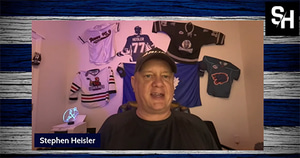JuniorHockey.io
IF I WERE KING: NORTH AMERICAN HOCKEY LEAGUE COVERS THE CONTINENT The North American Hockey League could do itself a big favor by breaking up the divisions into individual leagues and merging with the Canadian Junior Hockey League.
Sep 24, 2024
Play: AI Text To Voice
Let’s look at the concept by the numbers. Such a move would not only give individual divisions more control over their hockey operation and funding standards, but it would also give the NAHL brand a broader appeal equal to the brand itself.
The CJHL is really 118 Junior “A” clubs spread out into nine leagues. At the Tier II level, the NAHL is currently 35 teams split into four divisions.
I would propose splitting the Ontario Junior Hockey League in two and adding the best teams from the Greater Ontario Hockey League to the each of the two groups.
Next would be putting more teams from the United States into the Kootenay International Junior Hockey League by adding select teams from the NA3HL’s Frontier Division to the mix. This trick would bring British Columbia back into the Tier II group.
The next move is more aggressive. The NAHL should break Alaska off into their own league and expand with three additional teams. Eagle River, Wasilla, and Whitehorse (Yukon Territory) could easily form and support teams, especially without the burden of a $750,000 buy-in.
Would NAHL and CJHL owners even consider such a major reorganization? The opportunity to operate somewhat independently, while being a part of a 16-league juggernaut with roster protection, could prove to be way too valuable to pass up.
Operational Independence
Let’s be realistic, what works in Shreveport may not be effective in Thunder Bay. Different areas of the continent depend on different funding practices to sustain itself. Ontario leagues have proven the ability to be competitive while partially being funded by player tuition fees.
This new NAHL should stay out of the business practices of individual leagues and let each region set standards for themselves. With that said, players should be free to choose the team and league that works best for individual goals and development. This means the elimination of drafts. This practice would force teams to compete for talent the old-fashioned way, by winning the recruiting battle and delivering on promises.
Leagues should be able to expand and contract as needed and allow the free-market system to dictate membership values.
Why?
Almost all the players at this level are in pursuit of the same prize; the opportunity to play college hockey. By standardizing information and celebrating each league’s cultural differences, players from remote markets will get the chance to showcase their abilities to schools on both sides of the border.
One of the biggest headaches for operators is also the ability to identify and retain talent. The NAHL would also turn into a bit of a marketplace for lower budget teams to develop and move talent to bigger clubs willing to pay for talent.
The advantage of such an NAHL superstructure would be the ability to collectively market the on-ice talent to a broader spectrum of sponsors, schools, and supporters. The NAHL would also quickly become the developmental base for players, coaches, and on-ice officials.
When it comes to putting on a heck of a show, nobody does it better than NAHL commissioner Mark Frankenfeld. Just imagine what he could do with 16 leagues of teams. A NAHL Finals with champions from all 16 leagues. Top Prospects, Futures Camps, Junior “B”, NAPHL, and more all operating under the expert eyes of the guy that’s changed the face of junior hockey on this continent.
We all know I am not the king, but we know who is…you. If you like this idea, share it with others. It is time to elevate North American hockey to where it used to be, the best developmental opportunity in the world.
